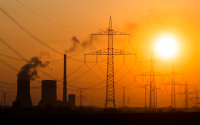It has arrived early; it's bigger than ever and it promises a summer of death and destruction. The annual "dead zone" in the Gulf of Mexico - starved of oxygen, and thus killing fish and underwater vegetation - has appeared earlier than usual this year.
This is just one sign of a rapidly growing crisis. The number of similar dead zones in the world's seas has doubled every decade since 1960, as a result of increasing pollution. The United Nations Environment Programme says that there are now 146 of them worldwide, mainly around the coasts of rich countries. Its executive director, Klaus Töpfer, calls their growth "a gigantic, global experiment ... triggering alarming, and sometimes irreversible, effects".
The Gulf of Mexico dead zone - which can cover more than 7,000 square miles - is mainly caused by fertilisers, flowing down rivers to the sea. Every year the Mississippi river - which drains 41 per cent of the United States - dumps 1.6 million tons of nitrogen in the gulf, three times as much as 40 years ago. Most comes from the highly productive corn belt, which helps to feed the world. The nutrients feed blooms of algae and phytoplankton. The algae drain oxygen from the water, as do the decomposing bodies of the plankton, when they fall to the seabed and die.
It hits a fishery that provides one-fifth of the country's entire harvest from the sea. As a result, catches of brown shrimp, the gulf's most important species, have dropped since 1990. The worst years match those with biggest dead zones, which appear to block juveniles from reaching their offshore spawning grounds. Last year, the dead zone was even blamed for a tripling in shark attacks on Texas bathers. Fish and swimming crabs flee the pollution for cleaner water, followed by the sharks.
Scientists recently found 19 locations with severely depleted oxygen in the gulf, where they expected to find none at this time of year. "It usually doesn't start until June," said Steven DiMarco, a researcher at Texas A&M University, one of several groups involved in the testing. "It was larger at that time than it was at any time in 2004. During January and February of this year, the flow of the Mississippi river was larger than at any time in 2004."
The stratification levels between the fresh river water and heavier salt water of the sea created the dead zone, which usually is at its most severe between 30 and 60 feet below the surface. The zone was first recorded in the early 1970s. It originally occurred every two to three years, but now returns each summer.
The world's biggest dead zone is in the Baltic, where sewage and nitrogen fallout from burning fossil fuels combine with fertilisers to over-enrich the sea. Fish farming can also exacerbate the problem.
Nearly a third of the world's dead zones are off the United States - including a notorious one in Chesapeake Bay - but they also cluster round the coasts of Europe and Japan, and have reached China, Brazil, Australia and New Zealand.
World fertiliser use has soared tenfold over the past 50 years, mirroring the increase in dead zones. And half the natural wetlands that used to filter out nutrients before they reach the sea have been destroyed worldwide. Big farming states such as Ohio, Indiana, Illinois and Iowa have drained more than 80 per cent of theirs.
But there is some good news. After the lobster fishery collapsed in the Kattegat Strait between Denmark and Sweden 20 years ago, the Danish government implemented an action plan, which dramatically cut pollution from agriculture, industry and sewage and restored wetlands.
Now new experimental programmes in the United States - which persuade farmers to use less fertiliser in exchange for a guarantee of compensation if their yields drop - have cut its use by a quarter. They raise the hope that, if expanded, the relentless growth of the dead zone in the Gulf of Mexico might finally be reversed.






